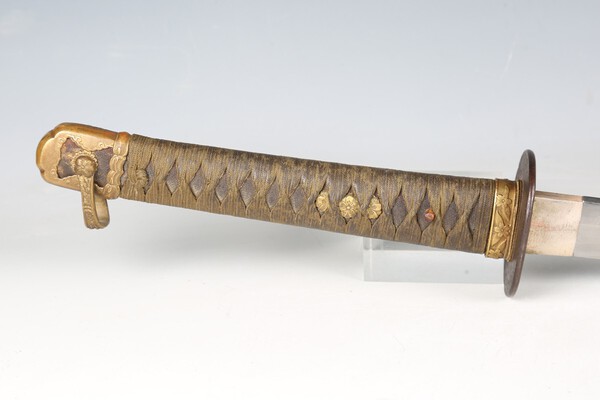-
Posts
13,796 -
Joined
-
Last visited
-
Days Won
169
Content Type
Profiles
Forums
Events
Store
Downloads
Gallery
Everything posted by Bruce Pennington
-

Wakizashi tameshigiri edo
Bruce Pennington replied to Hiro nakamura's topic in Translation Assistance
Average waki - $600 Above average- I’ve seen $2,600 Important blade- higher -
@Scogg after the translating is complete here, how about moving this over to the military section. I think it would be of interest to the guys that collect Type 32s.
-
Ah, I thought I recognized the red annotations. If you don’t get help here, I recommend taking the chart to Akira Komiya, Nick’s brother who is currently active on Warrelics. Or I can post it for you.
-
Who did the translating on this chart? Did you do this, or is it something from Nick Komiya?
-
The stamp was used from 1935 to 1942, with most dated blades found from 1940-1941.
-
Quite interesting to see "Officers at government offices" and "military police" being assigned the Type 32 Otsu! Hmmm
-
These are the two, 3rd and 4th gen, in Sesko's book: "KANESADA (兼貞), 3rd gen., Eishō (永正, 1504-1521), Mino – “Mino no Kuni-jūnin Uemon no Jō Kanesada” (美濃国住人右衛門尉兼貞), “Izumi no Kami Kanesada” (和泉守兼貞), “Kanesada” (兼貞), “Nōshū-jū Kanesada” (濃州住兼貞), first name Uemon (右衛門), according to tradition a student of the 1st gen. Kanesada (兼定, Oya-Kanesada), suguha mixed with ko-midare, notare mixed with gunome elements which tend to togari, jō-saku "KANESADA (兼貞), 4th gen., Daiei (大永, 1521-1528), Mino – “Izumi no Kami Fujiwara Kanesada” (和泉守藤原兼貞), “Seki-jū Kanesada saku” (関住兼貞作), “Kanesada” (兼貞), “Izumi no Kami Kanesada saku” (和泉守兼貞作), “Kanesada, Asamagadake ni oite kore o saku” (兼貞於朝熊岳是作, “made by Kanesada at Mt. Asama [Ise province]”), student of No-Sada, he followed his master to Ise where the latter had worked at some time in Yamada (山田) and Asamagatake (朝熊岳), it is said that he moved later to Echigo province, Sue-Seki style, robust sugata and often longer blades, standing-out itame mixed with masame, gunome mixed with chōji, frayed yakigashira, small tobiyaki, ryō-wazamono"
-
Hi Ambo, The first character is the katakana "SU", then 103. Fittings were marked to keep them all together, as they were custom fitted to each blade. You might even see a painted number on the blade that matches (not always). Love the see the rest of the fittings and blade. Is it signed?
-
兼貞 (Kanesada)
-
Plimpton called your version an "early model" of the Type 8 Dress Sword. Most version have more detail on the little curly thingy off the front end of the guard: While most saya (scabbards) were chromed, we have seen several come through with a darkened finish to them. Hard to say with yours with all the corrosion.
-
Jess, Could you post a photo of the face of the hand guard, better yet, a shot of the backstrap, which also shows the floral work in the hand guard, like this:
-

Why i dislike this dealer
Bruce Pennington replied to lonely panet's topic in Auctions and Online Sales or Sellers
I don't understand this last post. -

Nlf Gunto Discussion
Bruce Pennington replied to Bruce Pennington's topic in Military Swords of Japan
Here's one of those puzzling ones. Found on this Toovey's Auction. Mumei, no observable stamp, #65. Fittings are typical Army, but hey are not gold gilded. Most puzzling is the tsuka ito which clearly had been handled/carried considerably, look at the sweat stains. Adding to the list of souvenirs with sarute ... and this one is a bit unusual. -
Akira Komiya pointed out he men he is standing on are Army, and he believes the guy with large binoculars is an Army officer, so your idea that it was a civil sword in leather saya cover seems right on the money.
-

Increasing Gold Membership numbers?
Bruce Pennington replied to Brian's topic in General Nihonto Related Discussion
Brian, I think you can forget about worrying about us. We're here because we love doing this. It's a hobby, not a profession. The guys that like making money at this are already running their own businesses. Do whatever you need to do to Make NMB Great Again, and don't spend another second worrying about compensating us. Complimentary Gold memberships are an honor to receive and quite sufficient. Warrelics does the same thing. Don't know about other sites. -
I think Andre is having a bit of fun with us. The handguard, latch and scabbard throat mechanism is trying to imitate a WWII NCO Type 95. The metal ring belt hangar loop is also imitating WWII swords. So, the 'sacred sword' is trying to say it was made in WWII, but it wasn't. Still looking for close-ups of the blade tip, a shot of the temper line and one of the bare tang, if we are still playing.
-

Wakizashi tameshigiri edo
Bruce Pennington replied to Hiro nakamura's topic in Translation Assistance
The real experts will fill in the rest, but this last photo is the cut test mei of Hisahide, December 1665. On a personal note, I never realized they did cut tests on waki. And as an FWIW, this is the earliest cut tested blade I have of his on file. -
Like John says, we could use some photos of the blade - is there writing on it? - and the nakago (tang). At best, it is something made in the occupied territories. Photos will help.
-
Trystan, You caused me to go back to the Wehrmacht-awards thread, and sure enough, he stated the 3 photos were of "naval landing forces." So it was a Type 97. I can see a sarute in the navy kabutogane.
-
Thanks, Uwe. It is a bit odd. With all that corrosion, I'm surprised the mei is there at all, and I'm tempted to think it was added later by an unskilled hand.
-

Shin gunto with rattan saya exterior
Bruce Pennington replied to Gerry's topic in Military Swords of Japan
You were close. Guy's answer: "予士 [Yoka] 「陸軍士官学校 (日本)」の記事における「「陸士」・ 「予士」・「航士」」の解説 陸軍予科士官学校 Rikugun Yoka Shikan Gakko Army Officer Preparatory School Quick machine translation: Explanation of "Army Cadet," "Preparatory School," and "Navigation Officer" in the article "Army Academy (Japan)" For details, see "Army Preparatory School" and "Army Aviation Academy." From the dawn of the Imperial Japanese Army until its dissolution, the organization underwent several transformations. However, the educational system remained two-tiered, consisting of a main course and a preparatory course, as in the old system, with clearly distinct educational content (#Curriculum). In 1937 (Showa 12), ..... [etc] 「陸軍士官学校 (日本)」の記事における「「陸士」・ 「予士」・「航士」」の解説 詳細は「陸軍予科士官学校」および� �陸軍航空士官学校」を参照 帝国陸軍の黎明期からその解体まで� �織には幾度の変容があるが、教育段� ��は旧制学校と同様に本科と予科の二 層立てであり、教育内容も明確に異� �る(#教育課程)。1937年(昭和12年) には人員増加等を理由に、予科は「� �軍予科士官学校」と分離独立した学� ��となった。同時期、現役航空兵科将 校(陸軍航空部隊向けの航空要員た� �現役兵科将校)の教育に特化させた� ��科として、「陸軍航空士官学校(当 初は「陸軍士官学校分校」)も分離� �立している。これらはそれぞれ「陸� ��」・「予士」・「航士」などと略称 された(#歴史)。........" -
Hey guys, Can I get one of you magicians to read this one for me, please? It's on a nice, upgraded navy dirk:
-

Increasing Gold Membership numbers?
Bruce Pennington replied to Brian's topic in General Nihonto Related Discussion
Yes, and it's how I get a ton of stuff for my charts, too! Ha! But I understand what you guys are getting at. I don't mind the posts, as my hobby has morphed into just being here to help new guys with their questions. If we don't allow that, we just become an insular bubble of old farts incestuously wallowing in our own stuff. It's like having a "City name" Japanese Sword Club that only allows people to show up if they join first. But I totally get Brian's problem with growing data needs and less than matching memberships/donations. Tough problem, for sure. NMB is like a public library where people can go to look up stuff and learn, yet needing the financial support to keep it open. It is a struggle all non-profits and not-for-profits constantly deal with. -
I know that shadowing and the fact that it's a black & white photo could be falsely giving the impression, but this could be a black painted saya. It's clearly a Type 95, steel tsuba (sorry Sam, no numbers, Ha!):



.thumb.jpg.e6fd453f9ec3c3bb742a73dbfbee76d9.jpg)













